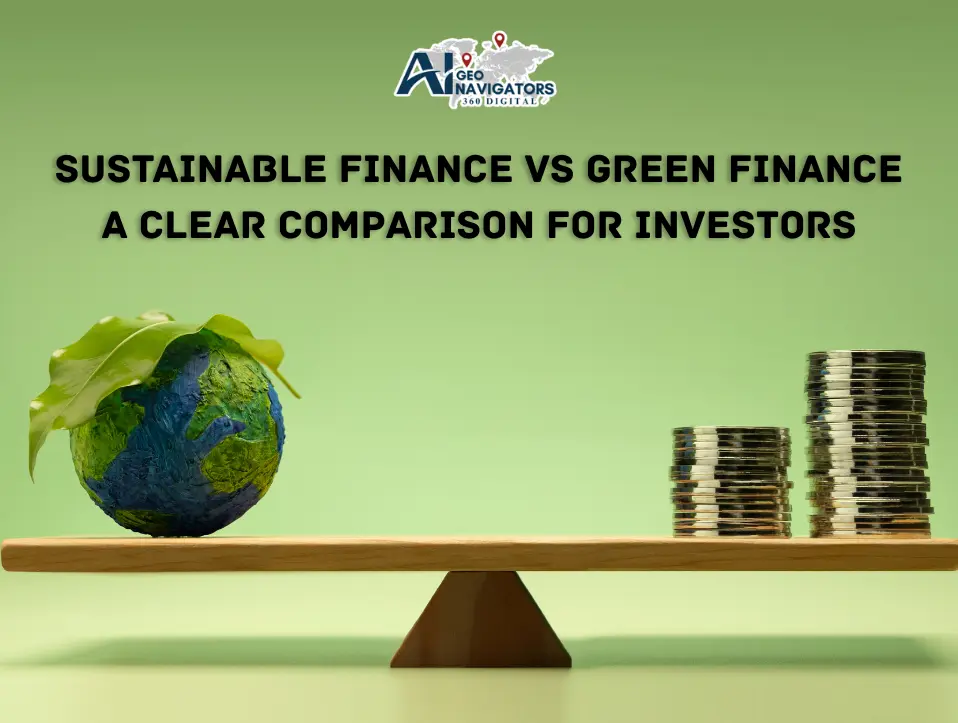In a world where climate change, social inequality and corporate governance are front and centre, finance cannot remain unchanged. Two terms you’ll often encounter in this evolving landscape are sustainable finance and green finance.
While they are related, they are not identical. Understanding how they differ, help you make better investment decisions, guide corporate strategy or simply make sense of the global push for more responsible capital flows.
In this blog we will:
- Define sustainable finance and green finance.
- Explore their core characteristics and objectives.
- Show how they compare side by side.
- Outline the types of instruments used in each.
- Dive into benefits, challenges and best practices.
- Explain why this matters for investors, companies and society.
What is Sustainable Finance?
Sustainable finance refers to a broad set of financial products, services, standards and approaches that integrate environmental, social and governance (ESG) considerations into financial decision making.
Key aspects include:
- Integrating ESG criteria across investment, lending, underwriting and advisory practices.
- Directing capital toward sustainable development goals (SDGs) and long-term value creation for both society and investors.
- Considering not just environmental issues, but also social outcomes (such as labour rights, inclusion) and governance matters (such as transparency, board structure).
Why Sustainable Finance Matters
- It aligns financial systems with the need for a transition to a low-carbon, resilient economy.
- It helps flag and manage risks associated with climate change, social disruption and weak governance.
- It opens new opportunities for markets, innovation and growth in sustainable sectors.
Examples of Sustainable Finance in Practice
- Investment funds that apply ESG screens and invest in companies with strong sustainability records.
- Loans or credit facilities that include sustainability-linked targets (for example reducing carbon emissions or improving employee diversity).
- Corporate bonds labelled as “sustainable” because they fund projects delivering environmental and social benefits.
- Banks and financial institutions revising risk frameworks to include climate and social risks.
What is Green Finance?
Green finance is a more specialised subset of sustainable finance. It focuses specifically on financing activities, projects and technologies that deliver environmental benefits particularly in respect of climate change mitigation, resource efficiency and ecosystem protection.
Key characteristics include:
- Focus on environmental objectives: renewable energy, clean transport, waste management, efficient buildings, biodiversity.
- Seeking to internalise environmental externalities (such as pollution, resource depletion) and adjust risk perceptions related to environmental harm.
- Using specific instruments like green bonds, green loans, sustainable infrastructure financing.
Why Green Finance Matters
- The environmental challenges we face (like climate change, biodiversity loss, pollution) require targeted capital flows.
- Green finance helps channel money into projects that otherwise may struggle to attract investment because of their novelty or perceived risk.
- It plays a critical role in transitioning economies toward lower-carbon and resource-efficient models.
Examples of Green Finance in Practice
- A bond issued specifically to fund a large-scale solar farm or wind power project.
- A loan extended by a bank to a company upgrading its production facilities to consume less water and emit fewer pollutants.
- Public-private partnerships that raise funds to retrofit old buildings for energy efficiency.
- Insurance or guarantee programmes designed to de-risk green infrastructure investments.
Comparing Sustainable Finance vs Green Finance
Here is a side-by-side comparison of the two to clarify their similarities and differences:
| Feature | Sustainable Finance | Green Finance |
| Scope | Broad: addresses environmental, social and governance issues. | Narrower: focuses primarily on environmental benefits. |
| Objectives | Long-term value creation, risk mitigation, inclusive growth. | Environmental transition, resource efficiency, emission reductions. |
| Instruments | ESG funds, sustainability-linked loans, impact investments, general sustainable bonds. | Green bonds, green loans, dedicated funds for environmentally-friendly infrastructure. |
| Stakeholder focus | Environmental + Social + Governance (three pillars). | Primarily Environmental; social/governance may be secondary or not addressed. |
| Risk & assessment | Wide variety of risks (climate, social, governance) considered. | More focused on environmental risk (e.g., climate risk, pollution risk). (Ecotsy) |
| Impact measurement | More complex: includes social and governance metrics, often harder to measure. | More targeted: for environmental projects the outcomes (e.g., MW of renewables, tonnes CO₂ avoided) can be more straightforward. |
Key Insights
- Green finance is a subset of sustainable finance. Many sources illustrate this relationship.
- Sustainable finance offers the broader framework. Green finance offers depth in a specific area (environment).
- Investors, companies and regulators may choose either or both depending on their goals.
- Because green finance is more specific, it may allow clearer attribution of environmental benefits — but may miss out on the wider social and governance aspects that sustainable finance captures.
Why the Distinction Matters
Understanding the difference between sustainable finance and green finance is not just academic, it matters in practice for several reasons:
1. Investment Strategy & Alignment
- If you are an investor looking for broad sustainability outcomes (e.g., social equality + governance reform + environmental improvement) you will lean toward sustainable finance.
- If you are focused on climate change mitigation, resource efficiency or specific environmental projects, you will lean toward green finance.
- Clarity helps you understand what you are getting, what risks you face, and what outcomes you can expect.
2. Risk Management
- Sustainable finance frameworks allow financial institutions to identify and mitigate a broad array of risks (e.g., labour disputes, governance failures, regulatory fines, climate liabilities).
- Green finance frameworks zoom in on environmental risks but might overlook social or governance issues if used in isolation.
3. Regulation & Reporting
- Regulatory regimes around ESG disclosure, sustainable finance taxonomy and standards are evolving. Institutions must ensure proper classification and reporting to avoid green- or sustainability-washing.
- For green finance specifically, clear definitions, verification and tracking of environmental outcomes is required.
4. Impact Measurement
- For sustainable finance you often need to measure multi-dimensional outcomes: environmental + social + governance.
- For green finance you can more immediately link to environmental metrics (for example, carbon emissions avoided, renewable energy capacity installed).
- Accurate measurement builds credibility and safeguards avoidance of misleading claims.
5. Communicating to Stakeholders
- Boards, investors, regulators and civil society are increasingly aware of sustainability issues. They expect transparent, credible commitments, whether in the broad sustainable finance category or the specific green finance one.
- Being clear which category you are operating under helps manage expectations and deliver measurable results.
Instruments and Tools in Sustainable & Green Finance
Let’s look at specific tools, products and approaches under each category.
Instruments under Sustainable Finance
- Sustainability-linked loans (SLLs): Loans where the interest margin or other terms are linked to the borrower’s achievement of predetermined sustainability performance targets (SPTs).
- Sustainable bonds: Bonds whose proceeds fund projects with sustainability benefits (environmental + social + governance).
- ESG funds: Investment funds that select companies based on ESG criteria, often integrating ESG risk assessments into portfolio construction.
- Impact investing: Capital deployed with the intention to generate measurable social and/or environmental impact alongside a financial return.
- Green- and sustainability-themed funds: Certain funds that blend green and broader sustainability objectives.
Instruments under Green Finance
- Green bonds: Debt instruments where proceeds are dedicated to environmentally beneficial projects (like renewable energy, clean transport, energy efficiency).
- Green loans: Loans where the use of proceeds is dedicated to a project with environmental benefit (for example, retrofitting for energy efficiency).
- Green infrastructure finance: Investment in infrastructure projects that support environmental objectives (e.g., waste water treatment, sustainable transport).
- Green credit lines: Bank credit facilities explicitly earmarked for environmental projects.
- Guarantees and insurance products for green projects: Financial products that reduce risk for green investments, making them more attractive.
Benefits of Sustainable and Green Finance
Benefits of Sustainable Finance
- Helps mobilise capital toward socially beneficial outcomes and long-term value creation.
- Encourages companies and financial institutions to strengthen governance, transparency and social inclusion.
- Broadens investment opportunities beyond traditional sectors, enabling participation in the transition economy.
- Enables better management of ESG-related risks which could otherwise impact financial performance.
Benefits of Green Finance
- Directly channels funds into environmental solutions and helps accelerate the low-carbon transition.
- Allows clearer tracking of environmental outcomes (which can help with impact reporting and stakeholder communication).
- Creates market demand for green technologies and infrastructure, driving innovation.
- Supports regulatory goals and commitments (e.g., climate targets, net zero pledges).
Challenges and Limitations
Challenges for Sustainable Finance
- Definition and boundaries can be fuzzy: what counts as “sustainable” across social, environmental and governance dimensions may vary.
- Measurement and reporting of social and governance outcomes tends to be harder and less standardised than pure environmental metrics.
- Risk of “sustainability-washing” where companies or funds claim to be sustainable without rigorous substantiation.
- Some investors may see slower or different types of returns relative to traditional strategies, which can limit adoption.
Challenges for Green Finance
- Projects may involve higher upfront costs or perceived risk (especially new technologies or infrastructure) limiting participation.
- Lack of universally accepted definitions and taxonomies in some jurisdictions has led to confusion.
- Monitoring and verification of environmental outcomes is critical but can be resource-intensive.
- Some projects eligible as “green” might ignore social or governance concerns — for example large infrastructure with environmental benefits but poor community consultation.
Best Practices for Investors, Companies and Policymakers
For Investors
- Clarify your objective: Are you seeking broad sustainable outcomes or specifically environmental ones?
- Ensure proper due diligence: Understand the framework, metrics and reporting for any sustainable or green investment.
- Check for transparency and verification: Does the issuer provide clear outcomes, impact measurement and third-party verification?
- Stay informed on regulation and taxonomy developments: Many jurisdictions are updating frameworks for sustainable/green finance classification.
- Consider the whole picture: risk, return, impact — not just one dimension.
For Companies
- Integrate ESG (for sustainable finance) or environmental criteria (for green finance) into core strategy rather than treating as an after-thought.
- Align financing structure with the intended use of funds — ensure proceeds are correctly allocated and reported.
- Provide clear disclosures and impact reporting — build trust among investors and stakeholders.
- Set realistic targets and track progress — both for environmental outcomes and broader social/governance goals.
- Engage with stakeholders (community, investors, regulators) to understand expectations and potential risks.
For Policymakers & Regulators
- Establish clear taxonomies and definitions for sustainable and green finance to reduce ambiguity.
- Encourage standardised reporting and disclosure frameworks so that comparability and transparency improve across markets.
- Support capacity building, especially in emerging markets, for evaluation, monitoring and verification of sustainable and green projects.
- Provide incentives, guarantees or blended finance mechanisms to reduce risk and attract private capital toward sustainability objectives.
- Monitor and address risks of green-washing and mis-labelling of financial products.
Conclusion
Sustainable finance and green finance are two powerful but distinct concepts in the drive to align capital with sustainable development. While green finance zooms in on environmental goals, sustainable finance casts a wider lens integrating environment, society and governance.
By understanding their differences and how they overlap, investors, companies and policymakers can make smarter decisions, better manage risk and contribute meaningfully to a future that is socially inclusive, environmentally sound and economically robust.
Whatever your role investor, business leader, policy maker, the message is clear: aligning financial flows with sustainability is no longer optional. The question is how you choose to navigate the path through a broad sustainable framework, a focused green strategy, or a blend of both.
Start now. Define your objectives. Choose your route. And make your capital count for both return and impact.


No responses yet